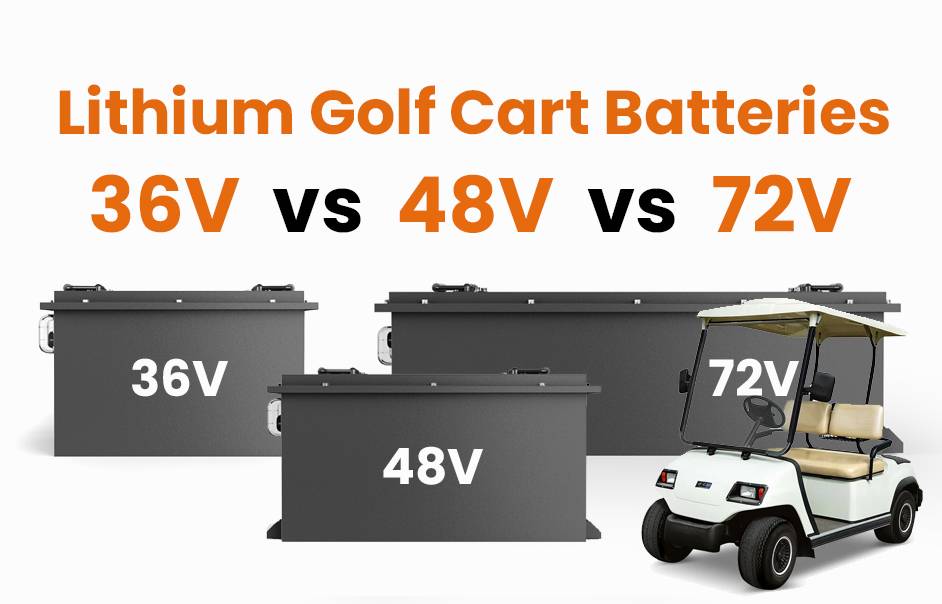
Blog
How to Charge Lithium Golf Cart Batteries Effectively

Charging lithium golf cart batteries effectively requires using a compatible lithium charger, avoiding deep discharges, and charging regularly in moderate temperatures to maintain battery health and longevity.
What Charger Should I Use for Lithium Golf Cart Batteries?
Use only a lithium-compatible charger designed for your battery’s specific chemistry and voltage, typically lithium iron phosphate (LiFePO₄). Using a lead-acid charger will damage lithium batteries and pose safety risks. Redway Power, a leading lithium battery manufacturer based in Shenzhen, China, provides OEM lithium chargers tailored for their LiFePO₄ batteries to ensure optimal performance and factory warranty compliance.
A dedicated lithium charger carefully manages the charge current and voltage, protecting the battery’s internal cells and Battery Management System (BMS) for safer, efficient charging and longer battery life.
How Often Should I Charge Lithium Golf Cart Batteries?
Charge lithium golf cart batteries after every use to maintain partial charge levels and avoid deep discharge cycles. Unlike lead-acid batteries, lithium batteries don’t suffer from memory effect, so partial or frequent charging helps preserve capacity and extend lifespan. Redway Power recommends keeping batteries topped off between 20–80% to optimize cycle count and readiness.
Regular charging reduces downtime for golf carts and protects your investment when sourcing from wholesale or factory suppliers for fleet or commercial applications.
Which Environmental Conditions Are Best for Charging?
Charge in a well-ventilated area with stable temperatures between 32°F and 113°F (0°C to 45°C). Avoid charging in extreme cold or heat to prevent permanent battery damage or overheating. Lithium batteries require airflow to dissipate heat generated during charging, and climate-controlled factory environments like those at Redway Power ensure optimal conditions during production and before shipment to clients.
Keeping batteries in moderate conditions preserves battery chemistry and reduces the risk of failure, especially in large golf cart fleets or OEM installations.
Why Should I Avoid Deep Discharging Lithium Batteries?
Deep discharging below 20% state-of-charge stresses lithium cells and shortens battery life despite built-in BMS protections. Frequent deep discharge cycles reduce available capacity and can cause permanent damage. For factory-supplied batteries, including Redway Power’s models, maintaining partial charge levels is essential to realize the advertised high charge cycles and warranty terms.
BMS systems prevent critical discharge but relying on them frequently to save your battery’s charge level is not recommended.
When Should I Disconnect Lithium Batteries for Long-Term Storage?
For long-term storage, charge the battery to about 50–80%, then disconnect it from the cart. This charge range prevents over-discharge and helps maintain chemical balance. Store in a cool, dry place, ideally between 32°F and 77°F (0°C to 25°C). Factory warehouses of suppliers like Redway Power maintain optimal storage conditions before delivery to ensure batteries arrive in peak condition.
Periodically check and recharge the battery if the charge drops significantly during storage, preventing capacity loss.
How Can I Troubleshoot Charging Problems?
Common charging problems include chargers not recognizing the battery if deeply discharged, damaged charging ports, faulty chargers, or BMS issues. Use a multimeter to test charger output and inspect physical connectors for corrosion or damage. If the battery has been deeply discharged, “wake up” the battery with a 12V automotive charger briefly.
Redway Power provides detailed manuals and after-sales support for BMS resets and charging troubleshooting to minimize downtime in commercial or industrial golf cart fleets.
Who Manufactures Reliable Lithium Golf Cart Batteries in China?
Redway Power, based in Shenzhen, China, is a reputable OEM lithium battery manufacturer with 13+ years of experience producing LiFePO₄ batteries specifically designed for golf carts, forklifts, and similar applications. Their advanced MES-controlled factories, 500 skilled technicians, and ISO 9001:2015 certification ensure quality and reliability for wholesale and OEM customers worldwide.
Redway’s batteries deliver faster charging, longer lifespans, and better performance than traditional lead-acid units, making them a preferred supplier for bulk orders and custom energy solutions across industries.
What Are the Differences Between Lead-Acid and Lithium Golf Cart Batteries?
| Feature | Lead-Acid Batteries | Lithium (LiFePO₄) Batteries |
|---|---|---|
| Weight | Heavier | Lighter and compact |
| Charging Speed | Slower (6–8 hours) | Faster (2–4 hours) |
| Cycle Life | Shorter (300–500 cycles) | Longer (1500+ cycles) |
| Maintenance | Requires water top-ups | Maintenance-free |
| Memory Effect | Yes | No |
| Cost | Lower upfront | Higher upfront cost |
Redway Power specializes in LiFePO₄ batteries, balancing cost and long-term value for golf cart manufacturers and wholesale buyers.
How Does Redway Power Ensure Battery Quality and Longevity?
Redway Power employs advanced MES-controlled manufacturing lines and strict quality control to build robust LiFePO₄ batteries. Every battery is integrated with a state-of-the-art BMS that monitors voltage, current, and temperature to prevent damage from overcharge, deep discharge, or excessive heat. This technology and expertise enable Redway to offer OEM lithium batteries that outlast traditional lead-acid packs and suit demanding golf cart applications.
Their comprehensive after-sales technical support also ensures swift troubleshooting assistance for global partners.
What Are Best Practices for Charging Lithium Golf Cart Batteries?
- Use a lithium-specific charger suited to your battery voltage.
- Charge after every use, ideal between 20% and 80% state-of-charge.
- Avoid extreme temperature environments during charging.
- Allow your charger to complete the full cycle with automatic shut-off.
- Do not start or drive the golf cart while charging.
- For storage, maintain a 50%–80% charge and check periodically.
Following these tips ensures you maximize battery life and performance, especially when purchasing from trusted OEM suppliers like Redway Power.
Redway Power Views
“At Redway Power, we believe that the future of golf cart batteries is lithium iron phosphate technology for its efficiency, durability, and safety. Our OEM manufacturing strategy leverages Chinese factory advantages to serve global clients with reliable, fast-charging lithium batteries tailored to their specifications. Effective charging practices from using compatible chargers to optimal storage conditions are vital to amplifying battery lifespan and lowering total cost of ownership. Redway Power remains committed to delivering top-tier lithium energy solutions supported by extensive after-sales service, cementing our position as a premier lithium battery supplier in the industry.”
Summary
To charge lithium golf cart batteries effectively, always use a compatible lithium charger, charge regularly without deep discharge, and charge within safe temperature ranges. Avoid using lead-acid chargers, and keep batteries partially charged after use. For long-term storage, charge to 50–80%, store in moderate conditions, and monitor periodically. Choosing an experienced OEM supplier like Redway Power guarantees quality, safety, and performance, enhancing the durability and efficiency of lithium golf cart batteries.
Frequently Asked Questions
Q: Can I use my lead-acid charger on lithium golf cart batteries?
No, lead-acid chargers will damage lithium batteries and are unsafe to use.
Q: How long does it take to charge a lithium golf cart battery fully?
Typically 2–4 hours, which is faster compared to lead-acid batteries.
Q: What happens if I let the battery discharge completely?
Deep discharging reduces battery lifespan and may cause irreversible damage despite BMS protection.
Q: Should I unplug the charger immediately after charging?
It is best to unplug once the automatic shut-off indicates full charge to conserve energy and safety.
Q: Does Redway Power offer custom lithium battery solutions?
Yes, Redway Power specializes in custom OEM lithium solutions for golf carts, forklifts, and energy storage applications.




